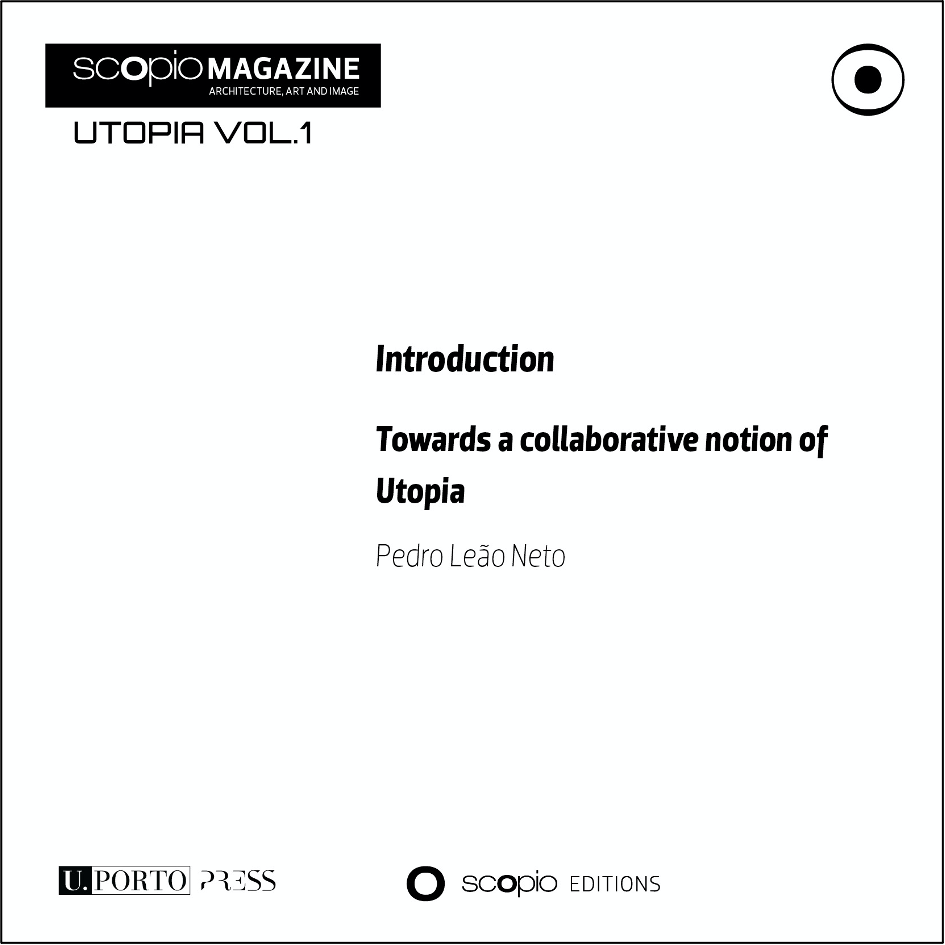
Towards a collaborative notion of Utopia
##plugins.themes.immersion.article.figure##

Resumo
scopio Architecture, Art and Image publication benefits from a renewed international Editorial Team and Scientific Committee and is now focused on disseminating the themes of Architecture, Art, Image (AAI). It has been integrated into a dynamic information space called scopionetwork with the collaboration of the Contrast project. Despite these changes, both the print and the online publications ensure the continuity of scopio’s original graphic identity and brand.
This open-access, annual, and research-orientated publication aims to offer critical, explorative and informative text targeting an interdisciplinary audience and providing a new critical space for discussion around the universe of AAI. It seeks, in particular, to debate / (re) think Architecture, Art and Image in our times.
Scopio AAI will be organised annually around a central theme, the focus of the first issue being Utopia. We want to challenge the ordinary understanding of this concept by exploring new ways of looking at Utopian thinking within today’s complex societies.
scopio AAI – Utopia aims to explore a notion of Utopia based on the idea that we need to have ambitious visions for the future and propose operational paths, creatively and collaboratively, towards transforming our society. We are interested in works by authors who believe that Utopia can be both a source of inspiration and a tool to create a better world. As advocated by Ernst Bloch eight decades ago in The Principle of Hope, because utopias offer visions of a better future world, they should be seen as part of our current reality and not be excluded from it. In this sense, utopias are inspiring images that guide us towards real possibilities and help us forge true social transformation.
We are interested in works that highlight the potential of Image as a medium that crosses borders and dislocates boundaries across different Architectural and Artistic subject areas. We call, in particular, for works by multidisciplinary teams inspired by broad notions of creativity, innovation and cybernetics as drivers of social and institutional co-evolution processes, exploring the potential of the world of Utopia and Image to inventively question and address cross-cutting problems affecting Architecture, Art and Image.
(...)
Referências
- Bloch, Ernst, 1885-1977. The Principle of Hope. Cambridge, Mass.: MIT Press, 1995.
- Jovchelovitch, S. &. (2018). Utopias and World-Making: Time, Transformation and the Collective Imagination. In: C. e. Saint-Laurent, Imagining collective futures. Perspectives from social, cultural and political psychology. Publisher: Palgrave Macmillan Editors: C. de Saint-Laurent, S. Obradovic, K. Carriere, pp. 133-5.
- Many authors have published on the relationship between architecture and Utopia. Nathaniel Coleman, for example, conducted research and has written extensively about these matters. See Nathaniel Coleman, Utopias and Architecture, 1st ed. (Londres: Routledge, 2005), 1.
- See Neto, Pedro Leão; Vieira, Fátima. «The universes of Architecture, Art and Image and Utopia». In DPIc: ARCHITECTURE, ART AND IMAGE – UTOPIA 500, 7-10. Porto, Portugal: scopio Editions, 2019
- Fishman, R 1996, ‹Urban Utopias: Ebenezer Howard and Le Corbusier›, in S Campbell & SFainstein (eds), Readings in Planning Theory, Blackwell Press, Cambridge, pp. 19-67.
- Jacobs, Jane. 1993. The Death and Life of Great American Cities. New York, NY: Vintage Books.
- Innerarity, Daniel. «Democracy without Politics: Why Democracy Can Seriously Harm Democracy». Studies in Media and Communication, vol. 5, n.º2 (2017), p. 76-84. https://www.researchgate.net/publication/297227864_Democracy_without_Politics_Why_Democracy_Can_Seriously_Harm_Democracy
- Raffaella Baccolini, «Dystopia Matters: On the Use of Dystopia and Utopia», Spaces of Utopia: An Electronic Journal, nr. 3, Autumn/Winter 2006, pp. 1-4 <http://ler.letras.up.pt > ISSN 1646-4729. https://ler.letras.up.pt/uploads/ficheiros/3056.pdf
Artigos mais lidos do(s) mesmo(s) autor(es)
- Pedro Leão Neto, About the jury’s evaluation , SCOPIO MAGAZINE ARCHITECTURE, ART AND IMAGE: Vol. 1 N.º 1 (2023): scopio Magazine AAI-Utopia
- Pedro Leão Neto, Maria Neto, About the published content on each section , SCOPIO MAGAZINE ARCHITECTURE, ART AND IMAGE: Vol. 1 N.º 1 (2023): scopio Magazine AAI-Utopia
- Pedro Leão Neto, José Carneiro, Visual Essays on Urbanity: A Photographic Journey through Architectural Transformations , SCOPIO MAGAZINE ARCHITECTURE, ART AND IMAGE: Vol. 1 N.º 1 (2023): scopio Magazine AAI-Utopia
- Pedro Leão Neto, Maria Neto, José Carneiro, Next Edition and Scopio & Contrast International Conference , SCOPIO MAGAZINE ARCHITECTURE, ART AND IMAGE: Vol. 1 N.º 1 (2023): scopio Magazine AAI-Utopia
- Pedro Leão Neto, Fátima Vieira, Drawing and Photography International Contest (DPIc) - Next Edition , SCOPIO MAGAZINE ARCHITECTURE, ART AND IMAGE: Vol. 1 N.º 1 (2023): scopio Magazine AAI-Utopia
